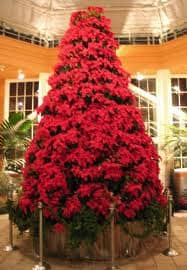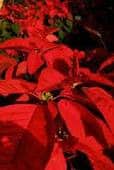
The Christmas Season just wouldn’t be the same without a beautiful Poinsettia decorating your home. Poinsettias are great potted plants and provide color for your home during and after the holiday season. They also make wonderful festive holiday gifts. Proper care is very important however for the plant to be able to maintain it’s vigor and beauty. Here are a few helpful tips to make your poinsettia last.
Keep your new Poinsettia plant near a sunny window where it will have the most available sunlight. Sunlight should be available for the plant at least five hours a day. A window that faces south, east or west is the best location to place your Poinsettia. Do take precaution not to let any part of your plant touch the cold windowpane. Poinsettias are sensitive to cold and the cold of the windowpane may injure it.
Watering your Poinsettia can be tricky. They are in the Euphoria Family and are native to Mexico. With this said they do not like to become too dry so you should never let the soil in the pot completely dry out. If you feel dryness on top of the soil when touching it, do water it until water runs freely out the drainage hole in the container. The pot should be able to drain the excess water as water logging in the pot is not good for Poinsettia. Waterlogged soil lacks sufficient air, which may result damage of roots. Poinsettias exposed to high light and low humidity require more frequent watering. However never water your poinsettia if the soil feels wet. Too much water will cause the leaves to curl up and then fall off. An over watered Poinsettia will drop all of it’s leaves and look very ” Naked.”
Maintain the temperature of the location where you have placed your plant at 65 to 70 degrees during the daylight hours for it to maintain it’s blooming. It is a good practice to move Poinsettias to a cooler place at night but it is not a demanding criterion. Because root rot disease is more prevalent at temperatures below 60 degrees F, do not put the poinsettia in a room colder than this.
Here are some interesting facts about Poinsettias you may not already know…..
1. Poinsettias are the most popular of all holiday plants.
2. Poinsettias ar e native to southern Mexico and Central America.
e native to southern Mexico and Central America.
4. Poinsettia’s botanical name, Euphorbia Pulcherrima, means “the most beautiful Euphorbia”.
5. Poinsettia was named after the former US ambassador to Mexico, Dr. Joel R. Poinsett, who introduced the Poinsettia to the United States.6. Research as proved that the Poinsettia is not poisonous.
7. Poinsettias, at times, reach a height of sixteen feet.
8. Poinsettias are also known by other names such as ‘Christmas flower’, ‘lobster flower’, and ‘Mexican flame leaf’.
Keeping your Poinsettia throughout the year and getting it to re bloom for next Christmas
can require a little work on your part as well as a lot of love. Most people think it is just easier to get a new plant next year than try to save and revive the old one. But if you just love your plant and cannot bear to throw it here are some guidelines to follow for a successful bloom next year..
Here is a little history on how Poinsettias became such a popular Christmas Plant.
 The ancient Aztecs (the Mexican Indians) prized the Poinsettia as a symbol of purity. Centuries later, Mexico’s early Christians adopted the Poinsettia as their prized Christmas Eve flower. The Mexican poinsettia, known as the Christmas flower in North America, is used in most Christmas decorations, owing to its bright red color and its blooming season coinciding with the Christmas holiday season.
The ancient Aztecs (the Mexican Indians) prized the Poinsettia as a symbol of purity. Centuries later, Mexico’s early Christians adopted the Poinsettia as their prized Christmas Eve flower. The Mexican poinsettia, known as the Christmas flower in North America, is used in most Christmas decorations, owing to its bright red color and its blooming season coinciding with the Christmas holiday season. The Mexican poinsettias are commonly bright red. For some, these star-shaped bracts symbolize the Star of Bethlehem. The Christmas Poinsettia flowers have become a symbol of Christmas and are used in festive decor.
A Mexican legend explains how Poinsettias came to be associated with Christmas. Apparently, a child who could not afford a gift to offer to Christ on Christmas Eve picked some weeds from the side of a road. The child was told that a humble gift, if given in love, would be acceptable in God’s eyes. When brought into the church, the weeds bloomed into red and green flowers and the congregation felt that they had witnessed a Christmas miracle.





